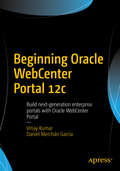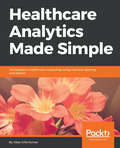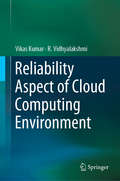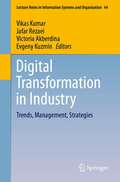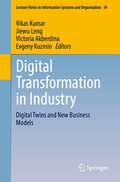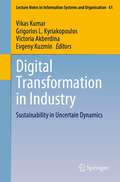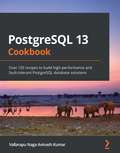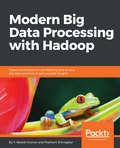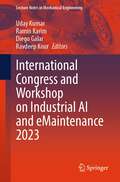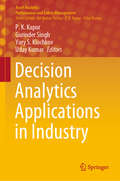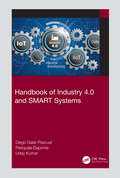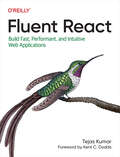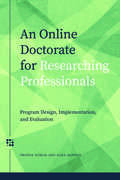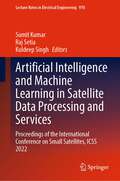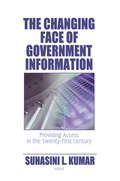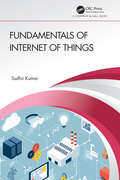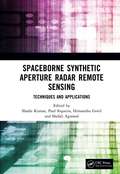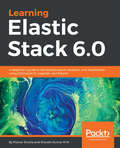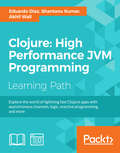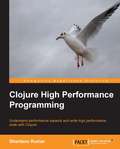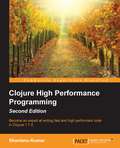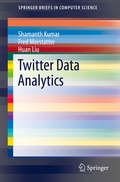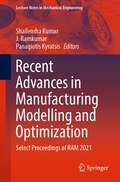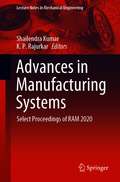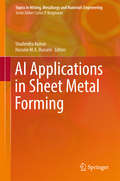- Table View
- List View
Beginning Oracle WebCenter Portal 12c: Build next-generation enterprise portals with Oracle WebCenter Portal
by Vinay Kumar Daniel Merchán GarcíaDevelop enterprise portals with Oracle WebCenter Portal 12c software and enrich those applications with social computing services, including discussions, documents, blogs, wikis, tags, and links. This book covers all functionalities and aspects from a developer, architect, and administrator point of view. Enterprise portal technology is used for creating intranet and extranet portals which enhance collaboration within a company. The book is intended to complete and fill in the gaps of the official documentation from an administrator and developer perspective. Beginning Oracle WebCenter Portal 12c provides an overview of the architecture behind Oracle WebCenter Suite and the Oracle Fusion Middleware platform. Sample code written in Java is included along with best practices developed from the authors' experience of using Oracle WebCenter Portal for building enterprise portals. What you will learn: Enterprise Portal and Oracle WebCenter Portal concepts Basic administrator knowledge Basic developer knowledge Overview of the tools and services offered by Oracle WebCenter Portal How to develop Portal Assets using JDeveloper IDE How to develop new components(Portlets JSR-286 and ADF Task Flows) using JDeveloper IDE REST API integration with Portal Enterprise content management with Portal Who this book is for: Developers, architects, project managers and portal administrators in the Oracle Fusion Middleware (FMW) area. IT professionals working in FMW or WebLogic stack can also make use of this book.
Healthcare Analytics Made Simple: Techniques in healthcare computing using machine learning and Python
by Vikas Vik KumarAdd a touch of data analytics to your healthcare systems and get insightful outcomesKey FeaturesPerform healthcare analytics with Python and SQLBuild predictive models on real healthcare data with pandas and scikit-learnUse analytics to improve healthcare performanceBook DescriptionIn recent years, machine learning technologies and analytics have been widely utilized across the healthcare sector. Healthcare Analytics Made Simple bridges the gap between practising doctors and data scientists. It equips the data scientists’ work with healthcare data and allows them to gain better insight from this data in order to improve healthcare outcomes.This book is a complete overview of machine learning for healthcare analytics, briefly describing the current healthcare landscape, machine learning algorithms, and Python and SQL programming languages. The step-by-step instructions teach you how to obtain real healthcare data and perform descriptive, predictive, and prescriptive analytics using popular Python packages such as pandas and scikit-learn. The latest research results in disease detection and healthcare image analysis are reviewed.By the end of this book, you will understand how to use Python for healthcare data analysis, how to import, collect, clean, and refine data from electronic health record (EHR) surveys, and how to make predictive models with this data through real-world algorithms and code examples.What you will learnGain valuable insight into healthcare incentives, finances, and legislation Discover the connection between machine learning and healthcare processesUse SQL and Python to analyze dataMeasure healthcare quality and provider performanceIdentify features and attributes to build successful healthcare models Build predictive models using real-world healthcare dataBecome an expert in predictive modeling with structured clinical dataSee what lies ahead for healthcare analyticsWho this book is forHealthcare Analytics Made Simple is for you if you are a developer who has a working knowledge of Python or a related programming language, although you are new to healthcare or predictive modeling with healthcare data. Clinicians interested in analytics and healthcare computing will also benefit from this book. This book can also serve as a textbook for students enrolled in an introductory course on machine learning for healthcare.
Reliability Aspect of Cloud Computing Environment
by Vikas Kumar R. VidhyalakshmiThis book presents both qualitative and quantitative approaches to cloud reliability measurements, together with specific case studies to reflect the real-time reliability applications. Traditional software reliability models cannot be used for cloud reliability evaluation due to the changes in the development architecture and delivery designs. The customer–vendor relationship mostly comes to a close with traditional software installations, whereas a SaaS subscription is just a start of the customer–vendor relationship. Reliability of cloud services is normally presented in terms of percentage, such as 99.9% or 99.99%. However, this type of reliability measurement provides confidence only in the service availability feature and may cover all the quality attributes of the product.The book offers a comprehensive review of the reliability models suitable for different services and deployments to help readers identify the appropriate cloud products for individual business needs. It also helps developers understand customer expectations and, most importantly, helps vendors to improve their service and support. As such it is a valuable resource for cloud customers, developers, vendors and the researchers.
Digital Transformation in Industry: Trends, Management, Strategies (Lecture Notes in Information Systems and Organisation #44)
by Vikas Kumar Jafar Rezaei Victoria Akberdina Evgeny KuzminThis book offers a selection of the best papers presented at the international scientific conference "Digital Transformation in Industry: Trends, Management, Strategies", held by the Institute of Economics of the Ural Branch of the Russian Academy of Sciences, Russia in November 2020. The main focus of the book is to evaluate trends and perspectives of digital transformation in industry and industrial markets through the dissemination of Industry 4.0. The aim of the topics discussed is to create an idea of introduction mechanisms for digitization processes and to specify successful strategies of digital transformation in all sectors of industrial enterprises. The experience of developed and developing economies, as well as small and large enterprises implementing IT and other technological innovations are included. Students as well as managers of industrial organizations alike can benefit from the results of the topics covered.
Digital Transformation in Industry: Digital Twins and New Business Models (Lecture Notes in Information Systems and Organisation #54)
by Vikas Kumar Jiewu Leng Victoria Akberdina Evgeny KuzminThis book offers a selection of the best papers presented at the annual international scientific conference “Digital Transformation in Industry: Trends, Management, Strategies (DTI2021),” held by the Institute of Economics, Ural Branch of the Russian Academy of Sciences, in Ekaterinburg (Russia) on October 29, 2021. The book focuses on the idea of introduction mechanisms for digitization processes and on highlighting successful digital transformation strategies in all sectors of industry. Key topics include the development of a cyber-physical production system for Industry 4.0; digital design technologies for enhancing the competitiveness of products and companies; digital twin-driven product manufacturing and services; and the effects of the industrial digital transformation on society and the environment. With regard to implementing IT and other technological innovations, lessons learned in developed and developing economies, as well as small and large enterprises, are included. Given its scope, the book offers a valuable asset for researchers and managers of industrial organizations alike.
Digital Transformation in Industry: Sustainability in Uncertain Dynamics (Lecture Notes in Information Systems and Organisation #61)
by Vikas Kumar Grigorios L. Kyriakopoulos Victoria Akberdina Evgeny KuzminThis book offers a selection of the best papers presented at the annual international scientific conference “Digital Transformation in Industry: Trends, Management, Strategies,” which was held by the Institute of Economics of the Ural Branch of the Russian Academy of Sciences (Ekaterinburg, Russia) on October 28, 2022.The book focuses on concepts for initiating digitalization processes and identifying successful digital transformation strategies in all sectors of industry. Key topics include the sustainability of digital transformation in uncertain dynamics; conditions of uncertainty and barriers; industrial logistics in the new reality; best practices for implementing digital solutions to ensure sustainable, barrier-free and flexible supply chains; the achievement of sustainability in the process of digital transition; the adaptation of enterprises to the ESG concept through digital solutions; assessing the impact of industrial digital transformation on society and the environment; and clarifying how ESG aspects affect the economy. The experiences of various countries, regions and types of enterprise implementing IT and other technological innovations are also included, making the book a valuable asset for researchers and managers alike.
PostgreSQL 13 Cookbook: Over 120 recipes to build high-performance and fault-tolerant PostgreSQL database solutions
by Vallarapu Naga KumarGet to grips with building reliable, scalable, and maintainable database solutions for enterprises and production databasesKey FeaturesImplement PostgreSQL 13 features to perform end-to-end modern database managementDesign, manage, and build enterprise database solutions using a unique recipe-based approachSolve common and not-so-common challenges faced while working to achieve optimal database performanceBook DescriptionPostgreSQL has become the most advanced open source database on the market. This book follows a step-by-step approach, guiding you effectively in deploying PostgreSQL in production environments. The book starts with an introduction to PostgreSQL and its architecture. You'll cover common and not-so-common challenges faced while designing and managing the database. Next, the book focuses on backup and recovery strategies to ensure your database is steady and achieves optimal performance. Throughout the book, you'll address key challenges such as maintaining reliability, data integrity, a fault-tolerant environment, a robust feature set, extensibility, consistency, and authentication. Moving ahead, you'll learn how to manage a PostgreSQL cluster and explore replication features for high availability. Later chapters will assist you in building a secure PostgreSQL server, along with covering recipes for encrypting data in motion and data at rest. Finally, you'll not only discover how to tune your database for optimal performance but also understand ways to monitor and manage maintenance activities, before learning how to perform PostgreSQL upgrades during downtime. By the end of this book, you'll be well-versed with the essential PostgreSQL 13 features to build enterprise relational databases.What you will learnUnderstand logical and physical backups in PostgresDemonstrate the different types of replication methods possible with PostgreSQL todaySet up a high availability cluster that provides seamless automatic failover for applicationsSecure a PostgreSQL encryption through authentication, authorization, and auditingAnalyze the live and historic activity of a PostgreSQL serverUnderstand how to monitor critical services in Postgres 13Manage maintenance activities and performance tuning of a PostgreSQL clusterWho this book is forThis PostgreSQL book is for database architects, database developers and administrators, or anyone who wants to become well-versed with PostgreSQL 13 features to plan, manage, and design efficient database solutions. Prior experience with the PostgreSQL database and SQL language is expected.
Modern Big Data Processing with Hadoop: Expert techniques for architecting end-to-end big data solutions to get valuable insights
by V Naresh Kumar Prashant ShindgikarA comprehensive guide to design, build and execute effective Big Data strategies using HadoopKey Features-Get an in-depth view of the Apache Hadoop ecosystem and an overview of the architectural patterns pertaining to the popular Big Data platform-Conquer different data processing and analytics challenges using a multitude of tools such as Apache Spark, Elasticsearch, Tableau and more-A comprehensive, step-by-step guide that will teach you everything you need to know, to be an expert Hadoop ArchitectBook DescriptionThe complex structure of data these days requires sophisticated solutions for data transformation, to make the information more accessible to the users.This book empowers you to build such solutions with relative ease with the help of Apache Hadoop, along with a host of other Big Data tools.This book will give you a complete understanding of the data lifecycle management with Hadoop, followed by modeling of structured and unstructured data in Hadoop. It will also show you how to design real-time streaming pipelines by leveraging tools such as Apache Spark, and build efficient enterprise search solutions using Elasticsearch. You will learn to build enterprise-grade analytics solutions on Hadoop, and how to visualize your data using tools such as Apache Superset. This book also covers techniques for deploying your Big Data solutions on the cloud Apache Ambari, as well as expert techniques for managing and administering your Hadoop cluster. By the end of this book, you will have all the knowledge you need to build expert Big Data systems.What you will learn Build an efficient enterprise Big Data strategy centered around Apache Hadoop Gain a thorough understanding of using Hadoop with various Big Data frameworks such as Apache Spark, Elasticsearch and more Set up and deploy your Big Data environment on premises or on the cloud with Apache AmbariDesign effective streaming data pipelines and build your own enterprise search solutions Utilize the historical data to build your analytics solutions and visualize them using popular tools such as Apache Superset Plan, set up and administer your Hadoop cluster efficientlyWho this book is forThis book is for Big Data professionals who want to fast-track their career in the Hadoop industry and become an expert Big Data architect. Project managers and mainframe professionals looking forward to build a career in Big Data Hadoop will also find this book to be useful. Some understanding of Hadoop is required to get the best out of this book.
International Congress and Workshop on Industrial AI and eMaintenance 2023 (Lecture Notes in Mechanical Engineering)
by Uday Kumar Ramin Karim Diego Galar Ravdeep KourThis proceedings brings together the papers presented at the International Congress and Workshop on Industrial AI and eMaintenance 2023 (IAI2023). The conference integrates the themes and topics of three conferences: Industrial AI & eMaintenance, Condition Monitoring and Diagnostic Engineering Management (COMADEM) and, Advances in Reliability, Maintainability and Supportability (ARMS) on a single platform. This proceedings serves both academy and industry in providing an excellent platform for collaboration by providing a forum for exchange of ideas and networking. The 21st century has seen remarkable progress in Artificial Intelligence, with application to a variety of fields (computer vision, automatic translation, sentiment analysis in social networks, robotics, etc.) The IAI2023 focuses on Industrial Artificial Intelligence, or IAI. The emergence of industrial AI applications holds tremendous promises in terms of achieving excellence and cost-effectiveness in the operation and maintenance of industrial assets. Opportunities in Industrial AI exist in many industries such as aerospace, railways, mining, construction, process industry, etc. Its development is powered by several trends: the Internet of Things (IoT); the increasing convergence between OT (operational technologies) and IT (information technologies); last but not least, the unabated fast-paced developments of advanced analytics. However, numerous technical and organizational challenges to the widespread development of industrial AI still exist. The IAI2023 conference and its proceedings foster fruitful discussions between AI creators and industrial practitioners.
Decision Analytics Applications in Industry (Asset Analytics)
by Uday Kumar P. K. Kapur Gurinder Singh Yury S. KlochkovThis book presents a range of qualitative and quantitative analyses in areas such as cybersecurity, sustainability, multivariate analysis, customer satisfaction, parametric programming, software reliability growth modeling, and blockchain technology, to name but a few. It also highlights integrated methods and practices in the areas of machine learning and genetic algorithms. After discussing applications in supply chains and logistics, cloud computing, six sigma, production management, big data analysis, satellite imaging, game theory, biometric systems, quality, and system performance, the book examines the latest developments and breakthroughs in the field of science and technology, and provides novel problem-solving methods. The themes discussed in the book link contributions by researchers and practitioners from different branches of engineering and management, and hailing from around the globe. These contributions provide scholars with a platform to derive maximum utility in the area of analytics by subscribing to the idea of managing business through system sciences, operations, and management. Managers and decision-makers can learn a great deal from the respective chapters, which will help them devise their own business strategies and find real-world solutions to complex industrial problems.
Handbook of Industry 4.0 and SMART Systems
by Uday Kumar Diego Galar Pascual Pasquale DaponteIndustry 4.0 refers to fourth generation of industrial activity characterized by smart systems and internet-based solutions. This book describes the fourth revolution based on instrumented, interconnected and intelligent assets. The different book chapters provide a perspective on technologies and methodologies developed and deployed leading to this concept. With an aim to increase performance, productivity and flexibility, major application area of maintenance through smart system has been discussed in detail. Applicability of 4.0 in transportation, energy and infrastructure is explored, with effects on technology, organisation and operations from a systems perspective.
Fluent React
by Tejas KumarWhen it comes to building user interfaces on the web, React enables web developers to unlock a new world of possibilities. This practical book helps you take a deep dive into fundamental concepts of this JavaScript library, including JSX syntax and advanced patterns, the virtual DOM, React reconciliation, and advanced optimization techniques. By becoming fluent in React, you'll quickly learn how to build better web applications.Author Tejas Kumar helps you explore the depths of React in plain English, without the typical software engineering jargon, so you can more easily understand how this JavaScript library works. You'll learn how to write intuitive React code that fully understands the nuances and layers of React, unlocking a whole new level of fluency.You will:Understand how React works at a deeper levelWrite React apps while optimizing them along the wayBuild resilient React applications that work well at arbitrary scaleCreate React applications for other platforms adjacent to the web and mobile devicesKnow when to reach for different mechanisms exposed by React, such as reducers versus state versus refs
An Online Doctorate for Researching Professionals: Program Design, Implementation, and Evaluation (Issues in Distance Education)
by Swapna Kumar Kara DawsonThe interest in and demand for online terminal degress across disciplines by professionals wishing to conduct research and fulfill doctoral degree requirements at a distance is only increasing. But what these programs look like, how they are implemented, and how they might be evaluated are the questions that challenge administrators and pedagogues alike. This book presents a model for a doctoral program that bridges theory, research, and practice and is offered completely or largely online. In their described program model, Kumar and Dawson enable researching professionals to build an online communtiy of inquiry, engage in critical discourse within and across disciplines, learn from and with experts and peers, and generate new knowledge. Their program design is grounded in the theoretical and research foundations of online, adult, and doctoral education, curriculum design and community-building, implementation and evaluation. The authors, who draw on their experience of implementing a similar program at the University of Florida, not only share data collected from students and faculty members but also reflect on lessons learned working on the program in diverse educational contexts. An important guide for program leaders who wish to develop and sustain an online professional doctorate, An Online Doctorate for Researching Professionals will also be a valuable resource for higher education professionals seeking to include e-learning components in existing on-campus doctoral programs.
Artificial Intelligence and Machine Learning in Satellite Data Processing and Services: Proceedings of the International Conference on Small Satellites, ICSS 2022 (Lecture Notes in Electrical Engineering #970)
by Sumit Kumar Kuldeep Singh Raj SetiaThis book, Artificial Intelligence and Machine Learning in Satellite: Data Processing and Services, presents the selected proceedings of the International Conference on Small Satellites (ICSS 2022) that aims to provide an opportunity for academicians, scientists, researchers, and industry experts, engaged in teaching, research, and development on satellite data processing and its services by employing advanced artificial intelligence-based machine learning techniques. This book covers the application of artificial intelligence and machine learning techniques in various domains of earth observations like natural resources and environmental management, water resources, urban and rural development, climate change, and other contemporary subjects. The book will surely be a valuable asset for beginners, researchers, and professionals working in satellite data processing and services using artificial intelligence and machine learning approaches.
The Changing Face of Government Information: Providing Access in the Twenty-First Century
by Suhasini L. KumarLearn what innovative changes lie in the future of government informationThe Changing Face of Government Information comprehensively examines the way government documents&’ librarians acquire, provide access, and provide reference services in the new electronic environment. Noted experts discuss the impact electronic materials have had on the Government Printing Office (GPO), the reference services within the Federal Depository Library Program (FDLP), and the new opportunities in the transition from paper-based information policy to an electronic e-government. This source reveals the latest changes in the field of government documents librarianship and the knowledge and expertise needed to teach users how to access what they need from this enormous wealth of government information.Major changes have taken place in the way government information is created, disseminated, accessed, and preserved. The Changing Face of Government Information explains in detail the tremendous change taking place in libraries and government documents librarianship. Topics include the increasing accessibility to the federally funded technical report literature, information on the Patriot Act&’s effect on the status of libraries in the aftermath of 9/11, the uses of Documents Data Miner©, and information about catalogs, indexes, and full text databases. This book also provides a selective bibliography of print and electronic sources about Native Americans and the Federal Government, as well as specific sources for information about the environment, such as EPA air data, DOE energy information, information on flora and fauna, hazardous waste, land use, and water. Each chapter is extensively referenced and several chapters use appendixes, tables, and charts to ensure understanding of data.This useful book gives readers the opportunity to learn: how the University of Oregon successfully integrated its business reference service and map collection into its government documents collection the results of a survey of FDLP institutions identifying the factors contributing to the reorganization of services details of the pilot project undertaken by the University of Arizona Library along with the United States Government Printing Office&’s Library Programs Service to create a model for a virtual depository library which critical features are missing in today&’s e-government reference service models details of the GPO&’s plans to provide perpetual access to both electronic and tangible information resources-and the strategies to authenticate government publications on the InternetThe Changing Face of Government Information is stimulating, horizon-expanding reading for librarians, professors, students, and researchers.
Fundamentals of Internet of Things
by Sudhir KumarThe Internet of Things (IoT) networks have revolutionized the world and have innumerable real-time applications on automation. A few examples include driverless cars, remote monitoring of the elderly, remote order of tea or coffee of your choice from a vending machine, and home/industrial automation amongst others. Fundamentals of Internet of Things build the foundations of IoT networks by leveraging the relevant concepts from signal processing, communications, net-works, and machine learning. The book covers two fundamental components of IoT networks, namely, the Internet and Things. In particular, the book focuses on networking concepts, protocols, clustering, data fusion, localization, energy harvesting, control optimization, data analytics, fog computing, privacy, and security including elliptic curve cryptography and blockchain technology. Most of the existing books are theoretical and without many mathematical details and examples. In addition, some essential topics of the IoT networks are also missing in the existing books. Features: • The book covers cutting-edge research topics• Provides mathematical understanding of the topics in addition to relevant theory and insights• Includes illustrations with hand-solved numerical examples for visualization of the theory and testing of understanding• Lucid and crisp explanation to lessen the study time of the reader The book is a complete package of the fundamentals of IoT networks and is suitable for graduate-level students and researchers who want to dive into the world of IoT networks.
Spaceborne Synthetic Aperture Radar Remote Sensing: Techniques and Applications
by Shashi Kumar Paul Siqueira Himanshu Govil Shefali AgrawalThis book provides basic and advanced concepts of synthetic aperture radar (SAR), PolSAR, InSAR, PolInSAR, and all necessary information about various applications and analysis of data of multiple sensors. It includes information on SAR remote sensing, data processing, and separate applications of SAR technology, compiled in one place. It will help readers to use active microwave imaging sensor-based information in geospatial technology and applications.This book: Covers basic and advanced concepts of synthetic aperture radar (SAR) remote sensing Introduces spaceborne SAR sensors Discusses applications of SAR remote sensing in earth observation Explores utilization of SAR data for solid earth, ecosystem, and cryosphere, including imaging of extra-terrestrial bodies Includes PolSAR and PolInSAR for aboveground forest biomass retrieval, as well as InSAR and PolSAR for snow parameters retrieval This book is aimed at researchers and graduate students in remote sensing, photogrammetry, geoscience, image processing, agriculture, environment, forestry, and image processing.
Learning Elastic Stack 6.0: A beginner’s guide to distributed search, analytics, and visualization using Elasticsearch, Logstash and Kibana
by Sharath Kumar Pranav Shukla Marcelo Ochoa Saurabh ChhajedKey Features - Get to grips with the new features introduced in Elastic Stack 6.0 - Get valuable insights from your data by working with the different components of the Elastic stack such as Elasticsearch, Logstash, Kibana, X-Pack, and Beats - Includes handy tips and techniques to build, deploy and manage your Elastic applications efficiently on-premise or on the cloud Book Description The Elastic Stack is a powerful combination of tools for distributed search, analytics, logging, and visualization of data from medium to massive data sets. The newly released Elastic Stack 6.0 brings new features and capabilities that empower users to find unique, actionable insights through these techniques. This book will give you a fundamental understanding of what the stack is all about, and how to use it efficiently to build powerful real-time data processing applications. After a quick overview of the newly introduced features in Elastic Stack 6.0, you’ll learn how to set up the stack by installing the tools, and see their basic configurations. Then it shows you how to use Elasticsearch for distributed searching and analytics, along with Logstash for logging, and Kibana for data visualization. It also demonstrates the creation of custom plugins using Kibana and Beats. You’ll find out about Elastic X-Pack, a useful extension for effective security and monitoring. We also provide useful tips on how to use the Elastic Cloud and deploy the Elastic Stack in production environments. On completing this book, you’ll have a solid foundational knowledge of the basic Elastic Stack functionalities. You’ll also have a good understanding of the role of each component in the stack to solve different data processing problems. What you will learn - Familiarize yourself with the different components of the Elastic Stack - Get to know the new functionalities introduced in Elastic Stack 6.0 - Effectively build your data pipeline to get data from terabytes or petabytes of data into Elasticsearch and Logstash for searching and logging - Use Kibana to visualize data and tell data stories in real-time - Secure, monitor, and use the alerting and reporting capabilities of Elastic Stack - Take your Elastic application to an on-premise or cloud-based production environment
Clojure: High Performance JVM Programming
by Shantanu Kumar Eduardo Diaz Akhil WaliExplore the world of lightning fast Clojure apps with asynchronous channels, logic, reactive programming, and more About This Book • Discover Clojure's features and advantages and use them in your existing projects • Explore lesser-known and more advanced features, constructs, and methodologies such as asynchronous channels, actors, logic programming, and reactive programming • Measure and monitor performance, and understand optimization techniques Who This Book Is For If you're looking to learn more about its core libraries and delve into the Clojure language in detail, then this book is ideal for you. Prior knowledge of the Clojure language is required. What You Will Learn • Understand tools for the Clojure world and how they relate to Java tools and standards (such as Maven) • Write simple multicore programs using Clojure's core concepts, such as atoms, agents, and refs • Get to grips with Clojure's concurrency and state-management primitives in depth • Analyze latency using the Criterium library • Avoid reflection and boxing with type hints • Maximize the impact of parallelization, functional composition, and process transformation by composing reducers and transducers • Modify and add features to the Clojure language using macros • Test your code with unit tests, specs, and type checks to write testable code • Troubleshoot and style your Clojure code to make it more maintainable In Detail Clojure is a general-purpose language from the Lisp family with an emphasis on functional programming. It has some interesting concepts and features such as immutability, gradual typing, thread-safe concurrency primitives, and macro-based metaprogramming, which makes it a great choice to create modern, performant, and scalable applications. This learning path aims at unleashing the true potential of the Clojure language so you can use it in your projects. It begins with installing and setting up the Clojure environment before moving on to explore the language in depth. You'll get acquainted with its various features such as functional programming, concurrency, reducers, transducers, core.async and core.logic, and so on with a great level of detail. Moving on, you'll also learn how to enhance performance using Java interoperability and JVM-specific features from Clojure; you'll even master language features such as asynchronous channels, actors, logic programming, reactive programming, metaprogramming, and so on. This learning path combines some of the best that Packt has to offer in one complete, curated package. It includes content from the following Packt products: • Clojure for Java Developers by Eduardo Diaz • Clojure High Performance Programming, Second Edition by Shantanu Kumar • Mastering Clojure by Akhil Wali Style and approach This is an easy-to-follow, step-by-step guide to start writing Clojure programs, making use of all of its varied features and advantages.
Clojure High Performance Programming
by Shantanu KumarThis is a short, practical guide that will teach you everything you need to know to start writing high performance Clojure code.This book is ideal for intermediate Clojure developers who are looking to get a good grip on how to achieve optimum performance. You should already have some experience with Clojure and it would help if you already know a little bit of Java. Knowledge of performance analysis and engineering is not required. For hands-on practice, you should have access to Clojure REPL with Leiningen.
Clojure High Performance Programming - Second Edition
by Shantanu KumarBecome an expert at writing fast and high performant code in Clojure 1.7.0 About This Book * Enhance code performance by using appropriate Clojure features * Improve the efficiency of applications and plan their deployment * A hands-on guide to designing Clojure programs to get the best performance Who This Book Is For This book is intended for intermediate Clojure developers who are looking to get a good grip on achieving optimum performance. Having a basic knowledge of Java would be helpful. What You Will Learn * Identify performance issues in Clojure programs using different profiling tools * Master techniques to achieve numerical performance in Clojure * Use Criterium library to measure latency of Clojure expressions * Exploit Java features in Clojure code to enhance performance * Avoid reflection and boxing with type hints * Understand Clojure's concurrency and state-management primitives in depth * Measure and monitor performance, and understand optimization techniques In Detail Clojure treats code as data and has a macro system. It focuses on programming with immutable values and explicit progression-of-time constructs, which are intended to facilitate the development of more robust programs, particularly multithreaded ones. It is built with performance, pragmatism, and simplicity in mind. Like most general purpose languages, various Clojure features have different performance characteristics that one should know in order to write high performance code. This book shows you how to evaluate the performance implications of various Clojure abstractions, discover their underpinnings, and apply the right approach for optimum performance in real-world programs. It starts by helping you classify various use cases and the need for them with respect to performance and analysis of various performance aspects. You will also learn the performance vocabulary that experts use throughout the world and discover various Clojure data structures, abstractions, and their performance characteristics. Further, the book will guide you through enhancing performance by using Java interoperability and JVM-specific features from Clojure. It also highlights the importance of using the right concurrent data structure and Java concurrency abstractions. This book also sheds light on performance metrics for measuring, how to measure, and how to visualize and monitor the collected data. At the end of the book, you will learn to run a performance profiler, identify bottlenecks, tune performance, and refactor code to get a better performance. Style and approach An easy-to-follow guide full of real-world examples and self-sufficient code snippets that will help you get your hands dirty with high performance programming with Clojure.
Twitter Data Analytics
by Shamanth Kumar Fred Morstatter Huan LiuThis brief provides methods for harnessing Twitter data to discover solutions to complex inquiries. The brief introduces the process of collecting data through Twitter's APIs and offers strategies for curating large datasets. The text gives examples of Twitter data with real-world examples, the present challenges and complexities of building visual analytic tools, and the best strategies to address these issues. Examples demonstrate how powerful measures can be computed using various Twitter data sources. Due to its openness in sharing data, Twitter is a prime example of social media in which researchers can verify their hypotheses, and practitioners can mine interesting patterns and build their own applications. This brief is designed to provide researchers, practitioners, project managers, as well as graduate students with an entry point to jump start their Twitter endeavors. It also serves as a convenient reference for readers seasoned in Twitter data analysis.
Recent Advances in Manufacturing Modelling and Optimization: Select Proceedings of RAM 2021 (Lecture Notes in Mechanical Engineering)
by Shailendra Kumar J. Ramkumar Panagiotis KyratsisThis book presents the selected proceedings of 2nd International Conference on Recent Advances in Manufacturing (RAM 2021). The book provides insights to current research trends and opportunities in modelling and optimization of manufacturing processes and systems. The topics covered include modelling analysis, computing and simulation, traditional and non-traditional optimization techniques, surface coating methods, additive manufacturing processes, CAD/CAM, robotics and automation, welding and joining processes, supply chain management and CAE and reverse engineering. This book will be a good reference for beginners, researchers and professionals interested in modelling and optimization related to manufacturing engineering and related fields.
Advances in Manufacturing Systems: Select Proceedings of RAM 2020 (Lecture Notes in Mechanical Engineering)
by Shailendra Kumar K. P. RajurkarThis book presents the select proceedings of the International Conference on Recent Advances in Manufacturing (RAM 2020). The volume focuses on latest research trends in manufacturing systems such as CAE, CAD/CAM, robotics and automation, reverse engineering, resource planning and simulation, computer-integrated manufacturing (CIM) systems, product life-cycle management, collaborative engineering, process monitoring control and traceability technologies, supply chain management, environment risk analysis, and manufacturing systems of renewable energy devices. The topics covered also include emerging fields of the fourth industrial revolution such cyber physical systems and cyber security, and wireless sensors and sensor networks for manufacturing. This book will be of interest to researchers and practitioners interested in latest developments in the field of manufacturing systems.
AI Applications in Sheet Metal Forming (Topics in Mining, Metallurgy and Materials Engineering)
by Shailendra Kumar Hussein M. A. HusseinThis book comprises chapters on research work done around the globe in the area of artificial intelligence (AI) applications in sheet metal forming. The first chapter offers an introduction to various AI techniques and sheet metal forming, while subsequent chapters describe traditional procedures/methods used in various sheet metal forming processes, and focus on the automation of those processes by means of AI techniques, such as KBS, ANN, GA, CBR, etc. Feature recognition and the manufacturability assessment of sheet metal parts, process planning, strip-layout design, selecting the type and size of die components, die modeling, and predicting die life are some of the most important aspects of sheet metal work. Traditionally, these activities are highly experience-based, tedious and time consuming. In response, researchers in several countries have applied various AI techniques to automate these activities, which are covered in this book. This book will be useful for engineers working in sheet metal industries, and will serve to provide future direction to young researchers and students working in the area.
